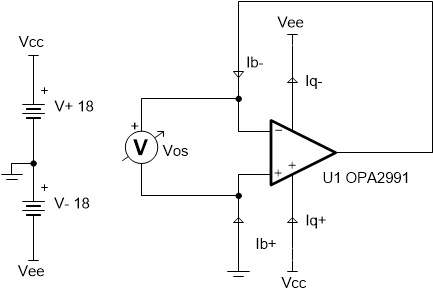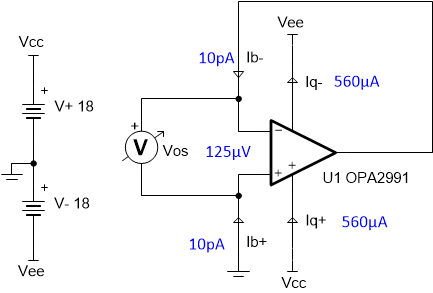SNOA475F October 2016 – September 2020 LMV791
- Trademarks
- 1Introduction
-
2What Parameters Should Be Tested?
- 2.1 Open-Loop Gain (AOL) and Phase Margin
- 2.2 Slew Rate
- 2.3 Common-Mode Rejection Ratio (CMRR) and Power Supply Rejection Ratio (PSRR)
- 2.4 Open-Loop Output Impedance (Zo)
- 2.5 Voltage Noise (en)
- 2.6 Current Noise (in)
- 2.7 Input Offset Voltage (VOS), Input Bias Current (Ib), and Quiescent Current (IQ)
- 2.8 Output Voltage Versus Output Current (Claw Curve)
- 2.9 Overload Recovery Time (tOR)
- 2.10 Common-mode Input Capacitance (CCM) and Common-mode Differential Capacitance (CDIFF)
- 2.11 Overshoot and Transient Response
- 2.12 Common-Mode Voltage Range (CMVR)
- 3Conclusion
- Revision History
2.7 Input Offset Voltage (VOS), Input Bias Current (Ib), and Quiescent Current (IQ)
Offset Voltage (VOS) is the differential voltage that would have to be applied at the input to force the op amp's output to 0V; VOS happens due to the mismatch of input transistors. Typically, general-purpose op amps have offset voltages ranging from mV down to μV. Changing power-supply voltage or common mode voltage will affect input offset voltage of an op amp.
Input bias current (Ib) is the average of bias current at the inverting and non-inverting input of the op amp. These currents can be modeled as a current source connected to each input. Ideally, the two input bias currents would be equal to each other and would cancel out. In reality they are not equal, and the difference of these currents is defined as input offset current (IOS). If IOS is low, it is possible to match the impedances connected to each input and cancel the offset developed from Ib. To learn more about VOS and Ib, please refer to the Texas Instruments Precision Labs video series on VOS and Ib.
Quiescent current (IQ) is the current level in an op amp when it is producing zero output. IQ is also known as the idle state current. Power dissipated due to IQ is simply equal to the total supply voltage multiplied by IQ. IQ is listed in the electrical characteristics table of the data sheet. To learn more about IQ, please refer to Texas Instruments Precision Labs video series on slew rate.

For many general-purpose applications, VOS and Ib are amongst the first parameters that are considered when selecting an op amp, whereas for some low-power applications IQ is one of the most important parameters. VOS can be modeled as a DC error voltage in series with the op amp's non-inverting input. Vos does not change with frequency but drifts over temperature. Ib and IQ can be modeled as a DC current source flowing from each op amp's input pin to ground. Like VOS, these do not change significantly over frequency but exhibit temperature drift. It is important to keep in mind that models are typically made with 25C conditions. Be cautious when using large input or feedback resistors because the resulting voltage drop across those resistors may cause DC errors. Figure 2-21 shows the Electrical Characteristics table from the data sheet giving both typical and maximum values for OPA2991. Op amp SPICE models are commonly designed to show typical behavior, not maximum, but check with the manufacturer if there's any confusion about a particular model. Figure 2-22 shows the recommended test circuit.
 Figure 2-21 Data Sheet Specification of
Vos, Ib, IQ for OPA2991
Figure 2-21 Data Sheet Specification of
Vos, Ib, IQ for OPA2991 Figure 2-22 Vos, Ib,
IQ Test Circuit
Figure 2-22 Vos, Ib,
IQ Test Circuit This circuit is a voltage-follower with the non-inverting input of the op amp grounded. Current meters are placed at both op amp inputs in order to measure Ib+ and Ib-, and the differential voltmeter to measure the VOS across the inputs of the op amp pins. Ensure that the power supply voltage and input common-mode voltage match the test conditions given in the op amp's data sheet. Figure 2-23 shows the simulated results for OPA2991. Comparing the measured results to Figure 2-21, we can see that the simulated results match well with the data sheet for OPA2991. For a more complete simulation test analysis, please refer to the following EDN article, authored by Ian Williams. This circuit may be simulated by downloading the AN1516 Test Circuits in either TINA-TI™ or PSpice® for TI.
 Figure 2-23 Simulate VOS,
Ib, and IQ for OPA2991
Figure 2-23 Simulate VOS,
Ib, and IQ for OPA2991